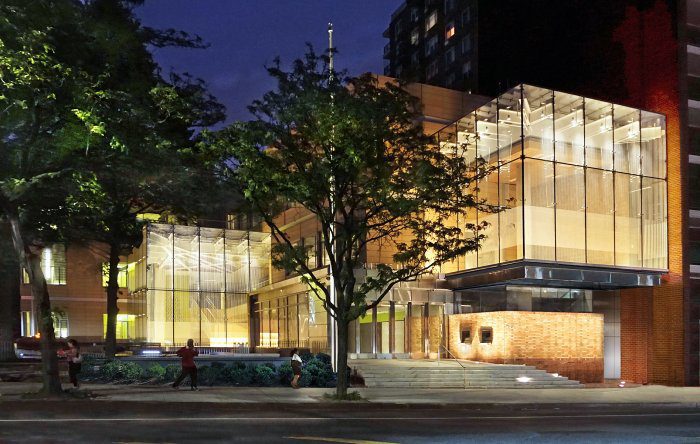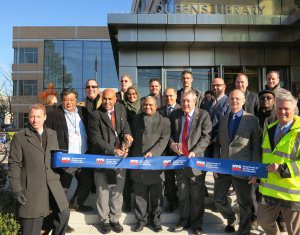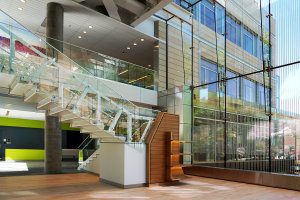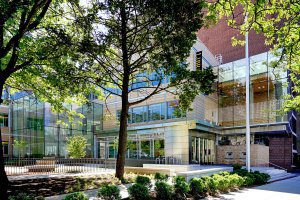Queens Library Leadership, Stalco Construction, Marpillero Pollak Architects and Local and National Political Leaders Open New $32.4 Million Elmhurst Community Library

ELMHURST, N.Y. _ Queens Library President and CEO Dennis M. Walcott, Queens Borough President Melinda Katz, New York City Council Member Daniel Dromm, New York City Council Majority Leader Jimmy Van Bramer, U.S. Congresswoman Grace Meng, NYS Assembly Member Francisco P. Moya, Stalco Construction President Alan Nahmias, NYC Department of Design and Construction Commissioner Feniosky Peña-Mora and local residents today celebrated the grand opening of Elmhurst Community Library with a ribbon cutting ceremony on the front steps of the new building. The library is located at 85-08 51st Avenue in Queens, NY.

Queens Library leadership, Stalco Construction, Marpillero Pollak Architects, NYC Department of Design and Construction, and local and national political leaders opened the new, $32.4 million Elmhurst Community Library, expected to be the busiest public library branch in the U.S., serving 1.2 million visitors annually. Back row, left to right: DDC Associate Commissioner of Public Buildings Eric Boorstyn, Stalco Construction Vice President Joseph M. Serpe, Stalco Superintendent Kevin Strebel, and DDC Deputy Commissioner of Public Buildings Tom Foley. Second row, left to right: Stalco President Alan Nahmias, DDC Junior Project Manager Shaima Rizvi, DDC Project Manager Davood Ghanizadeh, Stalco Assistant Project Manager Jason Vasquez, and DDC Deputy Director of Public Buildings Winston Sealey. Front row, left to right: DDC Executive Director of Public Information Ian Michaels, DDC Associate Commissioner of Public Buildings Mario Siribana, DDC Associate Commissioner of Public Buildings Oscar Gonzalez, DDC Commissioner Feniosky Peña-Mora, New York City Council Member Daniel Dromm, Marpillero Pollak Architects Principal Sandro Marpillero, and DDC Program Director for Libraries Owen Foote.
Photo by Peter Wilk/Wilk Marketing Communications
“The new Elmhurst Community Library is a direct response to the changing needs and demographics of a vibrant, diverse neighborhood,” said Queens Library President and CEO Dennis M. Walcott. “We expect it to be the most heavily trafficked library in our system, and one of the busiest in the country, with 1.2 million children, adults and teens coming here to learn, dream, explore and get what they need to navigate through life. We are grateful to the many individuals who made this day possible, from our partners in government to our staff and our volunteers, and look forward to meeting and hopefully exceeding the expectations of our customers for this library.”

The monumental central stair in the main reading room serves as a focal architectural feature and invites patrons to ascend to the second floor of the library.
Photo by Taigo Itadani
The new library, designed by Marpillero Pollak Architects and built by Stalco Construction, was funded by the Queens Borough President and the New York City Council, and overseen by the New York City Department of Design and Construction. New York City Department of Design and Construction managed the project.
The 32,000-square-foot, terra cotta-clad structure with two large, protruding glass cubes was designed and built to meet LEED Silver standards. It houses four, fully accessible levels for library service, separate adult, teen and children’s library sections, an adult learner center on its own level, 24/7 book return, an early learning center with a play kitchen, a large international collection with materials in nine languages and an English language collection with 27,000 items for adults, 28,000 items for children and young adults and nearly 15,000 multimedia items.

The 32,000-square-foot, terra cotta- and metal-clad structure features two large, protruding glass cubes, two green roofs, 13,000 square feet of outdoor space, and a Percent for Art art installation by the artist Allan McCollum. It was designed and built to meet LEED Silver standards.
Photo by Taigo Itadani
The new building replaces a 1906 Carnegie library that was half its size and previously stood on the site. The fireplace mantel from its children’s room was moved into the new children’s room and brickwork from its façade surround the foyer of the Broadway entrance. The structure features two green roofs, 13,000 square feet of outdoor space, and a Percent for Art art installation by the artist Allan McCollum comprised of 955 similar, yet distinct shapes cut from Grey Elm veneer plywood.
“The new Elmhurst Library is a magnificent facility that will be a center of learning, literacy and culture for residents of all ages for decades to come,” said Queens Borough President Melinda Katz. “This beautiful building will be a welcoming community hub where residents can enjoy Queens Library’s educational and cultural programs, its computer services, and its vast collection of books and other media. I commend the New York City Department of Design and Construction, Queens Library and all the officials involved in this project for all they have done to make this great new library a reality.”
“The Elmhurst Library is back and better than ever,” said NYC Council Member Daniel Dromm (D-Elmhurst, Jackson Heights). “I welcome this beautiful state-of the-art facility into the community. Libraries are a vital part of every NYC neighborhood. They connect our children with the resources they need to learn and offer them a quiet place to study. Libraries also serve as community centers for our seniors. This new and improved building will ensure that the Queens Library continues to meet the needs of the Elmhurst community. I thank Queens Library President Dennis Walcott and NYC Department of Design and Construction Commissioner Feniosky Peña-Mora for all they have done to bring about this exciting development.”
“As an 11-year veteran of the Queens Library, and the Chair of the Committee on Cultural Affairs and Libraries, I know first-hand how important libraries are to creating strong communities,” said New York City Council Majority Leader Jimmy Van Bramer. “When we invest in libraries, we invest in the future of our borough and our city. I am proud to help celebrate the grand opening of the new building of the Elmhurst Community Library, which will serve millions of children and adults for years to come.”
“A strong public library system is an indicator of equity in education,” said DDC Commissioner Feniosky Peña-Mora. “It exposes young people to resources that help them build a productive future, and it lets everyone know that this is a community that embraces knowledge and learning. The Queens Library system is thriving under the inspired leadership of Dennis Walcott, and is investing heavily in its future. DDC is proud to be a part of that investment in the community.”
“The library features numerous environmentally responsible materials and systems, green roofs, and energy-saving engineering solutions. It is one of the first projects to incorporate New York City’s Active Design Guidelines, a set of architectural principles that encourage building tenants and visitors to engage in a physical activity,” said Alan Nahmias, president of Stalco, the general contractor.
“I was honored when Percent for Art invited me to do a project for Elmhurst Community Library in Queens,” said the artist Allan McCollum, creator of the Percent for Art installation in the second floor reading area. “I had devised my “Shapes Project” to represent the vast diversity of people on our planet, and to be asked to present an iteration of this project in one of the most diverse neighborhoods in the country was like a dream come true.”
In addition to Stalco and Marpillero Pollak, the project team included structural engineer Severud Associates, MEP engineer ads Engineers, lighting designer See/Arch, and landscape architect Wallace Roberts & Todd.
Founded in 1896, Queens Library is an independent, non-profit library system and is one of three in the City of New York. It consists of a Central Library and 62 community libraries, which attract more than 11.2 million visitors each year. Queens Library is one of the highest circulating library systems in the nation and among the busiest in the world. Visit online at: http://www.queenslibrary.org/
Architecture
During the early design phase, MPA investigated patterns of use by library patrons. “We were impressed by the intensity with which the local community used the library: as a venue for social gathering, interaction between generations, educational facility, news and information source, internet access, cultural setting, and, of course, as a reading and books borrowing outlet,” said MPA Principal Linda Pollak. “Whenever we visited in the morning, there would be a large group of patrons outside, waiting for the library to open. It was clear that the library needed to expand in order to accommodate the community that places so much importance on it.”
The results of MPA’s initial analysis, including demographic patterns and forecasts, new library and learning technologies and Queens Library’s philosophy influenced the project’s architecture, interior design as well as outdoor spaces. “The architectural design for the library is based on three concepts: transparency, identities within a community, and ‘spine’,” explained MPA Principal Sandro Marpillero.
The transparency theme is the reflection of Queens Library’s mantra of transparency and visibility in the community it serves. The architects implemented it literally, creating a design that focuses on the visibility of the inner works of the new library both in its interiors and from the street vantage point. This is best represented by two 25-foot high structural glass cubes embedded in the building’s terracotta façade.
The Broadway cube, the most striking feature of the library’s exterior, showcases artist Allan McCollum’s large installation titled “Shapes”. The “Shapes” project, a series of artworks consisting of individual, unique, abstract shapes, symbolizes the concept of individuals with differences coming together as a community, the second theme of the architectural design. In addition to the main “Shapes” project, smaller installations are present in the main stairwell and elevators, providing clues about the shapes’ assembly.
The concept of the spine was borne out of the understanding of the library visit as an urban-like experience of exploring varied points of interest. MPA developed the urban spine concept as a concrete pathway that spans from the exterior sidewalk to become the main avenue of the library’s main floor in a consistent manner, with points of interest located along the way, including displays of new arrivals, a ‘newsstand’ with newspapers in many languages, and a history exhibition, as well as a monumental open ‘book’ stair, inviting patrons to ascend to the second floor of the library. The spine integrates exterior and interior of the library and leads visitors of all ages on the tour of exploration, as well as towards their various destinations: the library’s diverse program spaces, whose identities are conveyed through variously colored “portals.”
Construction
The new library houses an entry plaza, decorative wall commemorating the original library building, lobby with new arrivals display, Park Reading Room, Broadway Reading Room, teen space, children’s library, adult learning center and classrooms, two stairs, main circulation spine, Carnegie Room, and staff break room. The Park Reading Room is be located at the center of the building and visually connect to the adjacent park and garden, while the Broadway Reading Room overlooks the street and feature Allan McCollum’s 20’ x 20’ “Shapes” art wall installation.
“The project encompassed demolition of the pre-existing structure and construction of a three-story library building with an adjacent community park and learning garden. The new branch features a concrete foundation, steel frame structural system, terracotta-clad façade with metal bands, and two expansive glass cube spaces. The structural and architectural designs allow for a potential future expansion,” explained Stalco Superintendent Kevin Strebel.
The deepest point of excavation reached 30 feet below grade at the location of the ejector pit, in the northeast end of the site. The site is located atop capillaries feeding into the nearby Newton Creek, with the water table level reaching six feet above the bottom of the foundation. The watertight “bathtub” foundation system consists of the PRE-PRUF roll-out plastic liner by Gracie, sealed with self-adhesive tabs. The 30-inch thick reinforced concrete foundation mat slab rests above the liner. Construction of the mat slab required approximately 1,200 cubic yards of concrete delivered by more than 100 trucks. The 12-inch thick, reinforced concrete foundation walls stand atop the slab and reach the height of 14 feet above the slab.
The building’s structural system consists of a steel frame above the concrete foundation. The frame required 300 tons structural steel members. The foundation walls feature beam pockets with imbedded steel plates and anchor bolts pockets for steel columns. Following the installation of beams and columns the pockets were filled with grout. The beams above the lower level support the main floor of the new library. The longest beams, 28 feet long, provides an unobstructed, column-free space in the adult center.
Prior to the commencement of the excavation, the team underpinned the high-rise residential building directly adjacent to the south edge of the library site. The 47-foot long underpinning system consisted of a concrete wall extending the existing building’s foundations five feet down to reach the level of the excavation, as well as metal plates that reached the depth of 22 feet.
The logistics of the construction process were highly complex, as the site provided a very limited materials storage space and is bordered by two busy streets, including Broadway, a major commercial thoroughfare. The team obtained two one lane street closure permits, one on Broadway and one on 51st Street. In the initial phase of the construction process, the 51st Avenue lane was occupied by the site water removal and filtration system, preventing staging of construction operations. The majority of the construction site traffic took place on the Broadway side, with some deliveries taking place through the 51st Avenue gate.
“Stalco developed a detailed logistical and staging plan that coordinated deliveries of materials and removal of excavation debris. During erection of the steel structure for the building, Stalco carefully timed the deliveries of steel pieces to allow their installation or placement in correct sections of the site immediately upon arrival, which alleviated the issue of shortage of storage space,” said Stalco Vice President Joseph M. Serpe.
“The planning challenges included coordination of fabrication of a multitude of exterior materials, some custom manufactured in several countries. For example, the glass panels were manufactured in the U.K. and treated in Germany prior to the delivery to the construction site in Elmhurst,” added Strebel. The library’s exterior walls features stripes of terracotta tiles, metal panels, brick and expansive glass. The glass cubes feature prominently within the library’s building and incorporate an innovative structural system.
“In order to accelerate the construction process, Stalco began exterior envelope systems coordination and shop drawing development very early in the pre-construction phase,” continued Strebel. “Unusually for construction projects, the building’s envelope development began even prior to the structural steel shop drawing development. Stalco closely coordinated all shop drawings and ensured all fabricators developed their sections of the exterior wall with the understanding of the exact dimension requirements of other manufacturers and steel fabricators. The early planning for the complex exterior wall allowed the team to avoid delays caused by the unusually long lead items, such as the custom glass panels, which required up to 10 months to manufacture, review, approve and ship.”
The roofing system also presented the construction team with logistical and technical challenges. The new library features three different roof systems, including extensive and semi-intensive green roofs with vegetation. Stalco began fabrication work for the roofing systems early in the pre-construction phase as well.
An extensive green roof system is characterized by vegetation ranging from sedums to small grasses, herbs, and flowering herbaceous plants, which need little maintenance and no permanent irrigation system. The growing medium depth for an extensive green roof system is typically 6 inches or less. The semi-intensive green roof is a more complex system that allows for the inclusion of various perennials and small shrubs in the plant selection. The larger capacity of the drainage and water retention layer and the thicker layer of growing medium facilitate this broader plant spectrum.
Stalco Construction, Inc.
Headquartered in Islandia, NY, with a regional office in New York City, Stalco Construction, Inc. is a full-service general contracting and construction management firm active in the Greater New York area and on Long Island. Building Design & Construction magazine currently ranks Stalco as the 101st largest general contractor in the United States.
Established in 1992, the firm builds commercial and institutional facilities for office, retail, educational, healthcare, governmental, entertainment, and worship clients. Stalco’s personnel include engineers, architects, project managers, superintendents, and support staff. The value of the firm’s on-going ground-up, interior, and capital improvement projects totals approximately $100 million.
Since the firm’s inception, its leadership and employees have been involved in supporting the local community through responsible corporate citizenship and charity work. The company’s principals, Kevin G. Harney and Alan Nahmias, co-founded Contractors For Kids (CFK), a not-for-profit organization supported by nearly 300 Long Island-based construction and real estate organizations. CFK provides assistance to children and their families impacted by health-related crisis.
Stalco’s current and recent work includes the $8.4-million Asphalt Green Battery Park City recreational center and the $15-million restoration of the landmark Pier A in Manhattan; the $24-million renovation of the Vaughn College of Aeronautics and Technology in Queens, N.Y.; the $24-million Emergency Department at the Lincoln Medical and Mental Health Center in the Bronx; the $1.4-million Home Fair store at the Atlas Park Mall in Queens N.Y.; the Ultra Diamonds and Liebeskind Berlin stores in Riverhead, N.Y.; two Lush Fresh Handmade Cosmetics stores in Manhattan; and the on-call construction management contract for the 780,000-square foot One CA Plaza office complex in Islandia, N.Y.


